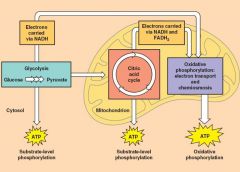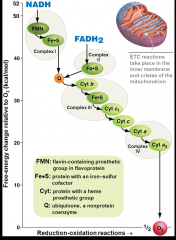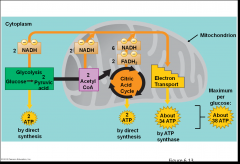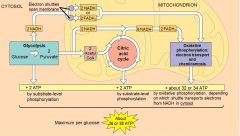![]()
![]()
![]()
Use LEFT and RIGHT arrow keys to navigate between flashcards;
Use UP and DOWN arrow keys to flip the card;
H to show hint;
A reads text to speech;
18 Cards in this Set
- Front
- Back
|
what is cellular respiration?
|
cellular respiration is the controlled release of energy from organic molecules (such as sugars) in cells to form ATP - Energy is stored in the molecule ATP, the energy currency of the cell |
|
|
Cellular respiration has to be controlled... how and why?
|
Why: explosive How: Redox reactions - oxidation and reduction OIL RIG oxidation: is the loss of electrons and hydrogens Reduction: is the gains of electrons and hydrogens |
|
|
glucose catabolism
|
the high energy electrons and hydrogens are stripped from glucose and picked up by NAD+ and FADH
|
|
|
electron transport chain
|
NADH and FADH2 passes electrons and hydrogens in a series of steps instead of one explosive reaction : uses the energy from the electron transfer to form ATP |
|
|
Stages of cellular respiration
|
1. glycolysis 2. Citric acid cycle 3. Oxidative phosphorylation; electron transport and chemiosmosis |
|
|
Glycolysis
|
:happens outside of the mitochondria in cytoplasm : breaks down glucose into pyruvate : glucose splits in half- NAD+ picks up electrons and hydrogen atoms from carbon molecules becoming NADH, some ATP is produced but not enough |
|
|
Glycolysis energy investment phase
|
- 2 molecules of ATP are consumed - Glucose is phosphorylated twice forming fructose- 1, 6-bisphosphate : glucose= 2 ADP + 2 P (ATP is used) |
|
|
Glycolysis energy payoff phase
|
:sugar is split to form two pyruvate molecules :2 molecules of NAD+ are reduced to NADH : 4 molecules of ATP are formed by substrate level phosphorylation (new Gain of 2 ATP) Glucose = 2 pyruvate + 2 H2O 4 ATP formed - 2 ATP used = 2 ATP 2 NAD+ + 4 e- +4 H+ = 2 NADH + 2 H+ |
|
|
Substrate level phosphorylation
|
a. occurs during glycolysis and the Krebs Cycle b. is a precursor for the phosphorylation of glucose c. is the source for the majority of the ATP produced in aerobic respiration d. occurs during the Krebs Cycle. -fancy way of describing the formation of ATP from ADP and inorganic phosphate (Pi), in a process that doesn't require oxidative phosphorylation (the process through which the majority of ATP are made during aerobic respiration). -It doesn't require oxygen so it can occur in glycolysis, where four ATP are produced by substrate-level phosphorylation: two and only two 1,3-bisphosphoglycerate are converted to 3-phosphoglycerate by transferring a phosphate group to ADP by the enzyme phosphoglycerate kinase; two phosphoenolpyruvate are converted to pyruvate by the transfer of their phosphate groups to ADP by the enzyme pyruvate kinase. -Once the pyruvate product of glycolysis is moved to the mitochondrial matrix, the pyruvate is converted to acetate and binds Coenzyme A to form Acetyl CoA to enter the Krebs cycle. While the Krebs cycle is oxidative respiration, one more instance of substrate-level phosphorlyation occurs as Guanosine triphosphate (GTP) is created from GDP by transfer of a phosphate group during the conversion of Succinyl CoA to Succinate. This phosphate is transferred to ADP in another substrate-level phosphorylation event. |
|

Citric Acid Cycle
|
to begin the citric acid cycle, pyruvate is converted into acetyl CoA - occurs in the mitochondria matrix -within the mitochondria, pyruvate is decarboxylated yielding acetyl-CoA, NADH and CO2 -the citric acid cycle complete the oxidation of organic molecules generating NADH and FADH2 molecules |
|
|
Steps of the citric acid cycle
|
1. Acetyl CoA stokes the fire 2 and 3. NADH, ATP and CO2 are generated during redox reaction 4 and 5: redox reactions generate FADH2 and NADH |
|

Oxidative Phosphorylation
|
Most ATP produced - involves electron transport and chemiosmosis - occurs in the inner membrane of the mitochondria : following glycolysis and citric acid cycle, NADH and FADH2 account for most of the energy extracted from food : These two electron carries donate electrons to ELectron Transport Chain, which creates a proton motive force by moving H+ across the inner mitochondrial membrane : the proton motive force (PMF) is used to make ATP and ATP synthesis |
|

Electron transport chain summary:
|
:Electrons are transferred from NADH or FADH2 to the electron transport chain. :The electron transport chain occurs in the folds of mitochondrion inner membrane. :The chain’s proteins relay electrons to each other while moving protons across the membrane :Electrons lose free energy as they go down the chain and are finally passed to O2, forming H2O. :The electron transport chain generates no ATP. The chain’s function is to pump protons into the inter membrane space, creating a proton gradient or PMF |
|
|
Main jobs of electron transport
|
1. push the H ions out 2. Chemiosmosis: let the H ions flow back into the mitochondrial matrix and turn the wheel of ATP synthesis |
|
|
Chemiosmosis:
|
the energy coupling machine - electrons transfer in the electron transport chain causes proteins to pump H+ from the mitochondrial matrix to the intermembrane space : H+ them moves back across the membrane, passing through channels in ATP synthase : ATP synthase (an enzyme) uses exergonic flow of H+ to drive phosphorylation of ATP : this is an example of chemiosmosis, The use of energy in a H+ gradient to drive cellular work |
|
|
Importance of oxygen
|
the oxygen you breath pulls electrons from the transport chain and water is formed as a byproduct : used to pump - creating an area of high H concentration, : High H concentration flow back across the membrane and this flow spins the turbine which activates the production of ATP |
|
|
Fermentation and anaerobic respiration enable cells to produce ATP without the use of oxygen
|
most cellular respiration requires O2 to produce ATP
|
|

|

|

